
29 minute read
CaroL H. and rICHard m. LeVIn Lots 1–33
Opposite Lot 17 Robert Henri Bridget Lavelle
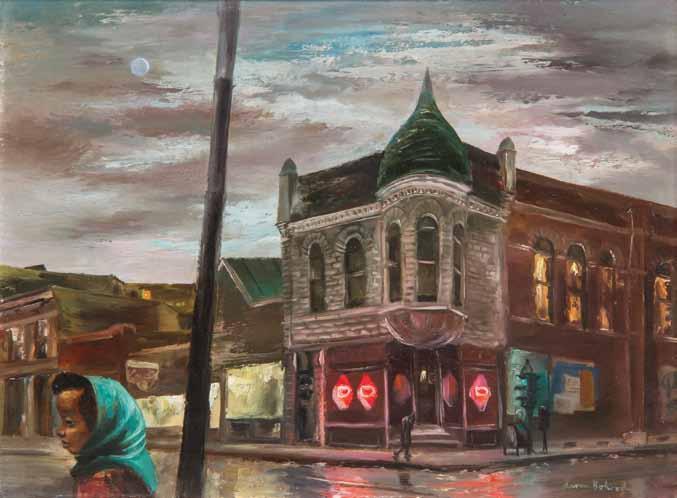
1
1 Aaron Bohrod (American, 1907-1992) South Side, Chicago oil on panel signed Aaron Bohrod (lower right) 12 x 16 inches. Property from the Collection of Carol H. and Richard M. Levin, Kansas City, Missouri
Provenance: Oehlschlaeger Gallery, Chicago Acquired directly from the above by the present owner, 1965 $3,000-5,000
2 William Gropper (American, 1897-1977) Jury oil on canvas signed Gropper (lower right); titled (verso) 13 7/8 x 36 inches. Property from the Collection of Carol H. and Richard M. Levin, Kansas City, Missouri
Provenance: ACA Gallery, New York Acquired directly from the above by the present owner, 1966 $6,000-8,000

3 Thomas Hart Benton (American, 1889-1975) Study for “Portrait of Carl Sandburg,” c. 1956 tempera on aluminum lithographic plate signed Benton (lower right) 12 x 8 inches. Property from the Collection of Carol H. and Richard M. Levin, Kansas City, Missouri
Provenance: The artist Acquired directly from the above by the present owner
This work will be included in the forthcoming Thomas Hart Benton catalogue raisonné being prepared by the Thomas Hart Benton Catalogue Raisonné Foundation. Committee Members: Dr. Henry Adams, Jessie Benton, Anthony Benton Gude, Andrew Thompson and Michael Owen. $30,000-50,000 THOmas HaRT BenTOn Study for “Portrait of Carl Sandburg”
A self-taught and frequently performing musician, Thomas Hart Benton was deeply interested in American folk music. As a child in the Ozarks, he was exposed to his maternal grandfather’s fiddle and mother’s piano playing. The artist made numerous expeditions throughout the Appalachians in the 1920s, wherein he sketched the musicians he met and admired “…their plaintive, slightly nasal voices and their way of short bowing the violin” (Thomas Hart Benton, An Artist in America, p. 113). While living in New York City in the early 1930s, Benton and his wife hosted Saturday evening music sessions, and in 1931 he taught himself how to play the harmonica.
Benton’s interest in folk music led him to eventually meet the poet, historian, social activist, and musician Carl Sandburg. Sandburg’s 1927 anthology of folk songs, the American Songbag, enjoyed enormous popularity, going through many editions. Sandburg himself is considered by many to be the first American urban folk singer, accompanying himself on solo guitar at lectures and poetry recitals, and in recordings. Both men sought to preserve and celebrate the living musical heritage of rural America and those who performed it.
Benton executed portraits of a number of notable people throughout his career, including former president Harry Truman, artist Stanton MacdonaldWright, and musician Carl Ruggles. In Study for “Portrait of Carl Sandburg,” Benton emphasizes the stillness of the poet-singer, who sits against a plain, dark backdrop and quietly gazes down at a sheaf of papers. Completed circa 1956, when Sandburg would have been seventy-eight, the artist respects his subject’s age and with active, broad brushstrokes shows his shock of white hair and craggy visage. The simplicity of the setting and the unyielding, honest depiction of the portrait highlight that here is an individual who has lived and experienced a full life.
This work is the only known study for the final painting of Sandburg by the artist, which resides in the collection of the Thomas Hart Benton Trust, Kansas City, Missouri.

3
4 Thomas Hart Benton (American, 1889-1975) Discussion, 1967 tempera on canvas wrapped around board signed Benton and dated (lower left); signed, titled and dated (verso) 16 x 20 inches. Property from the Collection of Carol H. and Richard M. Levin, Kansas City, Missouri
Provenance: The artist John W. Callison, acquired directly from the above, 1968 Acquired directly from the above by the present owner, 1987
Exhibited: Saint Joseph, Missouri, Albrecht Gallery of Art, February 6-March 1, 1970
Literature: Thomas Hart Benton, An American in Art: A Professional and Technical Autobiography, Lawrence, 1969, p. 144, illus. M. Baigell, Thomas Hart Benton, New York, 1974, n.p., no. 217, illus.
This work will be included in the forthcoming Thomas Hart Benton catalogue raisonné being prepared by the Thomas Hart Benton Catalogue Raisonné Foundation. Committee Members: Dr. Henry Adams, Jessie Benton, Anthony Benton Gude, Andrew Thompson and Michael Owen. $200,000-400,000 THOmas HaRT BenTOn diSCuSSion
As one of the foremost proponents of the Regionalist movement, Thomas Hart Benton was the champion of the common man. What he wanted most of all was to “make pictures, the imagery of which would carry unmistakenly American meanings for Americans” (Benton as quoted in M. Baigell, Thomas Hart Benton, New York, 1973, p. 87). The artist intended his dynamic, narrative paintings to be intelligible to all citizens and grounded in the values of the American republic. In Discussion, Benton monumentalizes a quintessentially American scene of the mid-20th century with his depiction of a laborer and union recruiter.
In 1937, Life hired Benton to travel to Flint, Michigan to report on the “sit-down” strikes against General Motors. The United Auto Workers union had recently achieved a major victory against the company, after months of occupation and court battles. Michigan was viewed as on the verge of a civil war between leftist union workers and union busters. Life wanted Benton to provide firsthand sketches of the conspiratorial communists and fascists, as they saw them. What resulted were seventeen comically benign drawings of various picnics and bar room discussions. When reproduced in Life, Study for “Discussion” (lot 5) was given the tongue-in-cheek caption, Tactical Discussion in Flint’s Smolny Institute, an allusion to Lenin’s headquarters during the 1917 October Revolution. What Benton shows is nothing more sinister than a conversation between an African American laborer and a union recruiter in Pengelly Hall, the headquarters of the UAW.
Benton often revisited past sketches, reworking ideas to create fully realized paintings. In 1967, he produced the present painting, based on Study for “Discussion.” In this work, the artist portrays the sitters in his characteristically sculptural style and removes any allusion to the union or the strikes. He instead emphasizes the communication between two fellow men, as one man reaches emphatically towards the other. In his commentary on the lithograph of the same image (lot 6) published in 1969, Benton writes: “Some newspaper reporters had written on these strikes as if they were the beginnings of revolution. I found neither talk about or desire for revolution - only an itch for more money. The drawing from which this lithograph was made represents a discussion between a union recruiter and a negro worker. The union boss sits in the background looking on” (Fath, p. 184). In all three works, Benton looks past the political fanaticism and depicts these men as individuals intent on a common goal.

4
5 Thomas Hart Benton (American, 1889-1975) Study for “Discussion” (also known as Tactical Discussion in Flint’s Smolny Institute), 1937 sepia wash, ink and pencil signed Benton (lower right) 8 1/2 x 11 inches. Property from the Collection of Carol H. and Richard M. Levin, Kansas City, Missouri
Provenance: The artist John W. Callison, acquired directly from the above, 1968 Acquired directly from the above by the present owner, 1987 Literature: “The Artist Thomas Hart Benton Hunts Communists and Fascists in Michigan,” Life, July 26, 1937, pp. 22-25, illus. K. A. Marling, Tom Benton and His Drawings, Columbia and London, 1986, p. 95, illus. H. Adams, Thomas Hart Benton: Drawing From Life, New York, 1990, p. 174, illus. E. Doss, Benton, Pollock, and the Politics of Modernism, Chicago, 1991, fig. 3.14, pp. 181, 184, illus.
Lot Note: On the verso of the present lot is a note in the artist’s hand that reads: “’Discussion’ made in 1937 in Flint, Michigan at time of famous ‘sit-down’ strikes. Used in Life July 26- ‘37.” - Thomas Hart Benton” $6,000-8,000
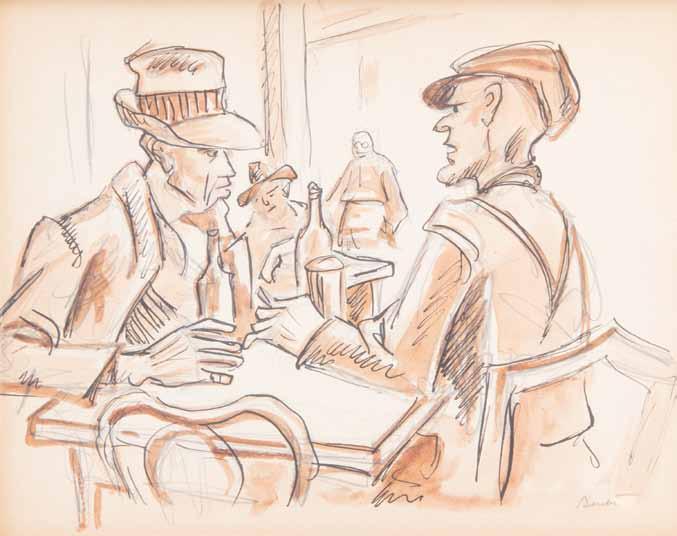
5

6
6 Thomas Hart Benton (American, 1889-1975) Discussion, 1969 lithograph; Associated American Artists, New York City, pub. edition of 250, signed Benton (lower right) 9 3/4 x 11 7/8 inches. Property from the Collection of Carol H. and Richard M. Levin, Kansas City, Missouri Ref: Fath, 82
Provenance: The artist John W. Callison, acquired directly from the above, 1968 Acquired directly from the above by the present owner, 1987 $2,000-4,000

7
Arguably one of the foremost leaders of the Regionalist movement, Thomas Hart Benton celebrated and embraced American life of the mid-20th century. His bold, sculptural compositions monumentalized the country’s land, its people, their beauty, strength, and often, tragedy. Study for “Flood Disaster (Homecoming - Kaw Valley)” is a painting the artist executed in 1951 in response to disastrous flooding of the Kansas River valley that summer. The flood destruction was the worst recorded in United States history up to that point, resulting in the displacement of over 500,000 people and seventeen deaths. Damages were estimated at 1 billion dollars, but the planned relief program would only provide 113 million dollars.
The hardest hit areas were working class neighborhoods such as Armourdale and Argentine, where the floods, and then a fire, ravaged thousands of homes. Benton traveled to the area several times to see the destruction first-hand, with the intent to create a painting that would stir America and Congress to provide greater aid to the region. During his tours of the Armourdale district, the artist produced sketches of the devastated neighborhood.
From these drawings, Benton developed a study that interpreted his firsthand observations, in order to develop a greater visual impact that he hoped would move people to action. In Study for “Flood Disaster (Homecoming - Kaw Valley),” a family comes back to inspect the remains of their home only to find everything they own displaced and in disrepair: a house nearly on its side and a stovepipe dangling from the branches of a tree. The artist successfully balances the theatrical nature of these components with a tender human element that is even more fully developed in the details of the final version of the painting (now in a the Collection of Jeanne and Rex Sinquefield, St. Louis, Missouri). However, the vivid colors and sense of energy imparted by the twisting figures that he first captures in this study remain the same.
In addition to the present study and final painting, Benton produced a lithograph of the same image to distribute to every member of Congress. While the lithograph failed to initially sway the Congressional vote for more funds, the artist’s gesture was certainly noticed and publicized. He appeared in the New York Times with this study and the lithograph on October 15, 1951. Several other news articles in the following months documented his efforts to aid the ravaged valley.
7 Thomas Hart Benton (American, 1889-1975) Study for “Flood Disaster (Homecoming - Kaw Valley),” c. 1951 tempera on board signed Benton (lower right) 8 1/2 x 10 3/4 inches. Property from the Collection of Carol H. and Richard M. Levin, Kansas City, Missouri
Provenance: The artist Acquired directly from the above by the present owner
Literature: “Artist Asking Congress to Aid Flood Victims,” New York Times, October 15, 1951
This work will be included in the forthcoming Thomas Hart Benton catalogue raisonné being prepared by the Thomas Hart Benton Catalogue Raisonné Foundation. Committee Members: Dr. Henry Adams, Jessie Benton, Anthony Benton Gude, Andrew Thompson and Michael Owen. $120,000-180,000

8

9
8 John Steuart Curry (American, 1897-1946) Self Portrait, 1946 oil on canvas signed John Steuart Curry and dated (lower left) 29 7/8 x 24 inches. Property from the Richard and Carol Levin Foundation, Kansas City, Missouri
Provenance: The artist Collection of Dr. Daniel Schuster and Mrs. Ellen Curry Schuster Vivian Kiechel Fine Art, Lincoln, Nebraska Acquired directly from the above by the present owner, 1996 Exhibited: Kansas City, Missouri, The Nelson-Atkins Museum, September 1998-January 1999 Kansas City, Missouri, The Nelson-Atkins Museum, Bingham to Benton: The Midwest as Muse, February 5-July 31, 2005 Kansas City, Missouri, The Nelson-Atkins Museum, February 5-October 31, 2009 $40,000-60,000 9 Moses Soyer (American, 1899-1974) The Dancers oil on canvas signed M. Soyer (lower right) 10 1/8 x 14 inches. Property from the Collection of Carol H. and Richard M. Levin, Kansas City, Missouri
Provenance: The artist Mrs. Lewis Hoffman, acquired directly from the above Acquired directly from the above by the present owner $3,000-5,000

10
10 Moses Soyer (American, 1899-1974) Nude with Blue Shawl oil on canvas signed M. Soyer (upper right) 20 x 16 1/8 inches. Property from the Collection of Carol H. and Richard M. Levin, Kansas City, Missouri
Provenance: ACA Galleries, New York Acquired directly from the above by the present owner, 1964 $1,500-2,500
11 Raphael Soyer (American, 1899-1987) Head of a Girl oil on canvas signed Raphael Soyer (lower right) 12 x 9 inches. Property from the Collection of Carol H. and Richard M. Levin, Kansas City, Missouri
Provenance: ACA Galleries, New York Acquired directly from the above by the present owner, 1968 $1,500-2,500

11

12 12 Reginald Marsh (American, 1898-1954) Girl in Blue Skirt and A 14th Street Shopper (a double-sided work), 1953 oil on board signed R. Marsh and dated (lower right); signed Reg. Marsh and dated (verso) 13 7/8 x 9 3/4 inches. Property from the Collection of Carol H. and Richard M. Levin, Kansas City, Missouri
Provenance: The Estate of Reginald Marsh Frank K. M. Rehn, Inc., New York Acquired directly from the above by the present owner, 1962 $6,000-8,000

(verso)
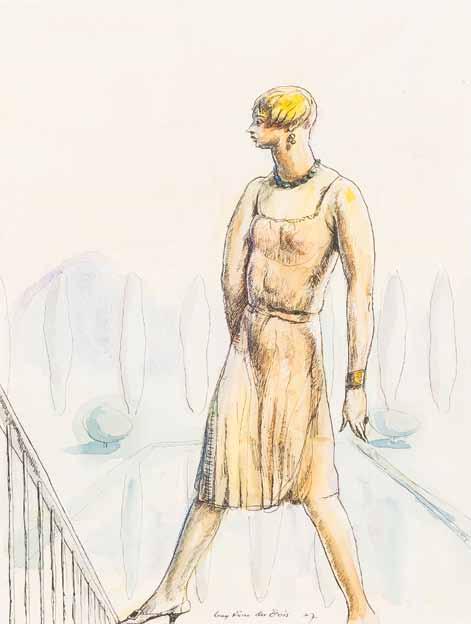
13
13 Guy Pène Du Bois (American, 1884-1958) Girl at Montparnasse, 1927 watercolor and ink on paper signed Guy Pène Du Bois and dated (lower center) 14 7/8 x 11 3/8 inches. Property from the Collection of Carol H. and Richard M. Levin, Kansas City, Missouri
Provenance: Paul Magriel, New York Hirschl & Adler Galleries, New York Acquired directly from the above by the present owner, 1991 Exhibited: New York, New York, The Finch College Museum of Art, and New Orleans, Louisiana, Isaac Delgado Museum of Art, Paul Magriel: Collection of American Drawings, June 9-August 31, 1961, no. 25 New York, New York, The American Federation of the Arts, One Hundred Years of AmericanRealism: Watercolors and Pastels from the Paul Magriel Collection,1964-66, no. 28 Oneonta, New York, The Museums at Hartwick, Hartwick College, The Art of the 20s, October-November, 1978 New York, New York, Kennedy Galleries, The Spontaneous Eye: American Drawings from the Twentieth Century, September 10-October 5, 1985 New York, New York, Hirschl & Adler Galleries, A Sense of Line: American Modernist Works on Paper, November 25, 1989-January 6, 1980 Literature: Kennedy Galleries, The Spontaneous Eye: American Drawings from the Twentieth Century, exhibition catalogue, New York, 1985, no. 5, illus. S. Schwartz, A Sense of Line: American Modernist Works on Paper, exhibition catalogue, Hirschl & Adler Galleries, New York, 1989-90, no. 10, p. 18, illus. $3,000-5,000
14 John French Sloan (American, 1871-1951) Playing to Empty Seats, 1913 crayon, frottage, watercolor, ink and charcoal on paper laid to illustration board signed John Sloan and dated (lower left) 23 x 16 3/4 inches. Property from the Collection of Carol H. and Richard M. Levin, Kansas City, Missouri
Provenance: Kraushaar Galleries, New York, 1936 Childs Gallery, Boston, 1952 Mr. and Mrs. Arthur G. Altschul Hirschl & Adler Galleries, New York Acquired directly from the above by the present owner, 1978
Exhibited: New York, New York, Folsom Galleries, Initial Exhibition of the American Salon of Humorists, April 17-May 1, 1915 Andover, Massachusetts, Addison Gallery of American Art, Phillips Academy, John Sloan Retrospective Exhibition, 1938 New York, New York, The Whitney Museum of American Art, This is Our City: An Exhibition of Paintings, Watercolors, Drawings and Prints, March 11-April 13, 1941, no. 131 New York, New York, The Whitney Museum of American Art, and elsewhere, John Sloan 1871-1951, January 10-March 2, 1952 New York, New York, The Century Association, Exhibition of Life in New York City, 1954 Minneapolis, Minnesota, University of Minnesota, University Gallery, and Grand Rapids, Michigan, Grand Rapids Art Gallery, Music and Art, April 4-May 18, 1958 New York, New York, The Breerly School, Parents Lounge, Art in the United States, Part 2, 19th and Early 20th Century, 1964 Washington, DC, National Gallery of Art, and elsewhere, John Sloan 1871-1951: His Life and Paintings, September 18- October 31, 1971, no. 90 Fort Worth, Texas, Amon Carter Museum of Art, and Los Angeles, California, Frederick S. Wight Art Gallery, University of California, The American Personality, The ArtistIllustrator of Life in the United States, 1860-1930, July 8-August 22, 1976 Kansas City, Missouri, The NelsonAtkins Museum of Art, Art of Paper: Highlights from the American Collection, February-December, 2009 Literature: Harper’s Weekly, December 6, 1913, p. 25, illus. “EXHIBITION OF AMERICAN HUMOR; “Salon of Humorists” at Folsom Galleries Has Plenty of Fun and Art and Is Distinctively American. Work of Well-Known Artists Represented Shows Moderation and Precision of Statement,” New York Times, April 18, 1915 Folsom Galleries, Initial Exhibition of the American Salon of Humorists, exhibition catalogue, New York, 1915 J. Sloan, Gist of Art, New York, 1939, p. 238 (incorrectly dated 1914), illus. Addison Gallery of American Art, John Sloan Retrospective Exhibition, exhibition catalogue, Andover, Massachusetts, 1938, no. 14, pp. 80, 82, illus. L. Goodrich, John Sloan 1871-1951, exhibition catalogue, New York, 1952, no. 119, p. 84 D. Scott, and E. John Bullard, John Sloan, 1871-1951: His Life and Paintings, exhibition catalogue, Washington, DC, 1971, no. 90, pp. 131, 215, illus. Amon Carter Museum of Art, The American Personality, The ArtistIllustrator of Life in the United States, 1860-1930, exhibition catalogue, Fort Worth, 1976, no. 234, pp. 110, 137, illus. H. Adams, American Drawings and Watercolors from the Kansas City Region, exhibition catalogue, Kansas City, 1992, pp. 142-144, illus. $60,000-80,000

14
jOHn FRenCH sLOan Playing to emPty SeatS
A leader of the Ashcan School and the Eight, John Sloan is best remembered for his urban scenes that chronicle the exuberant, gritty life of New York City. The artist started his career as a commercial illustrator in Philadelphia, where he worked with William Glackens, Everett Shinn, and Robert Henri. In 1904, encouraged by Henri to further pursue his painting career, Sloan and his wife Dolly moved to New York City so he could be at the site of the nation’s flourishing art scene. The vignettes the artist saw during long walks through his adopted hometown inspired much of his best work.
To supplement his painting income, Sloan continued to work as an illustrator, with contributions to magazines such as The Masses and Century. The present work was published in the December 6, 1913 issue of Harper’s Weekly. It proved popular and was exhibited extensively, including at Folsom Galleries, New York, in a 1915 show titled Initial Exhibition of the American Salon of Humorists. Sloan’s works in the exhibition are praised in a New York Times review, where the writer declares: “[the artist’s] depictions of the picturesque life of the poor, his avoidance of the insignificant and his power of grasping the salient features of a situation and placing them directly and effectively before the observer, show him a personality to be reckoned with in any estimate of modern American art, humorous or other” (New York Times, April 18, 1915).
In Playing to Empty Seats, Sloan has wittily encapsulated a fleeting scene of life in the streets and tenements of New York. Perhaps practicing for a future performance, a trio of musicians play in a littered alley, two cats their only audience. Above them wave lines of drying undergarments, the empty “seats” to which the title humorously refers. The laundry, alley fences, and surrounding buildings enclose the performers’ space and serve to emphasize the tumultuous, almost claustrophobic, cityscape. It is through this keen use of details that the artist successfully captures the spontaneous, joyous, and sometimes nonsensical, spirit of the city.
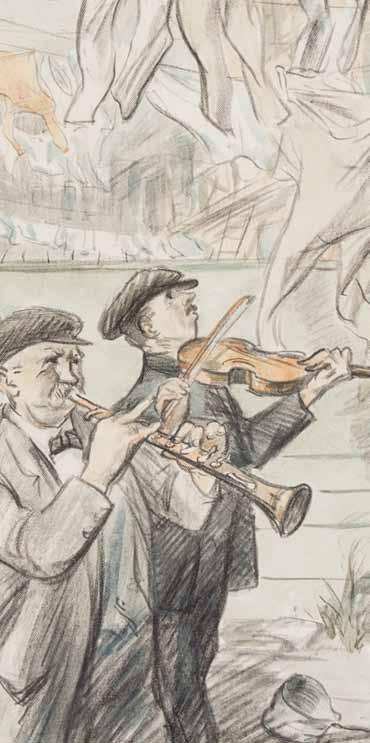

15
15 Everett Shinn (American, 1876-1953) Colored Banjo Player, 1940 gouache, watercolor, and gum arabic on paperboard signed Everett Shinn and dated (lower left); titled (verso) 11 3/8 x 7 7/8 inches. Property from the Richard and Carol Levin Foundation, Kansas City, Missouri
Provenance: ACA Galleries, New York Acquired directly from the above by the present owner, 1980 $15,000-25,000
17 Robert Henri (American, 1865-1929) Bridget Lavelle, 1926 oil on canvas signed Robert Henri (verso) 28 x 20 inches. Property from the Richard and Carol Levin Foundation, Kansas City, Missouri
Provenance: Estate of the artist Chapellier Gallery, New York Acquired directly from the above by the present owner, 1965 $400,000-600,000 ROBeRT HenRI bridget laVelle
A chief proponent of the Ashcan School, Robert Henri’s true artistic spirit is captured in his portraits, such as Bridget Lavelle. The artist’s portraits are principally concerned with capturing the essence of his sitters, who he referred to as “his people.” Henri’s search for authentic subjects led him and his wife, Marjorie Organ, to visit Achill Island, a remote location off the west coast of Ireland. They first visited in 1913 and again for four extended visits beginning in 1924, until Henri’s death in 1929. During their time on Achill, the couple rented and then purchased an estate, Corrymore. It was here that Henri created what is considered his most popular and widely recognized body of work, with his dynamic depictions of the children from the island.
The present work is recorded in the artist’s notebook as being painted in 1926 at Corrymore. Bridget was clearly one of the artist’s favorite subjects, as he painted her again at least three times in 1928, including Dark Bridget Lavelle (Albert-Kemper Museum of Art, St. Joseph, Missouri), and two titled Blonde Bridget Lavelle (one in the Collection of John and Susan Klein; the other in the collection of the Milwaukee Art Museum). The Lavelles were one of the oldest clans on the island and believed to be of French descent. In addition to Bridget, Henri portrayed several other members of the Lavelle family.
In Bridget Lavelle, Henri brilliantly captures his young sitter’s confident pose and unwavering gaze. Her assured presence is amplified through a sophisticated use of striking color. The artist often limited his color palette in the Irish portraits to a triad of essential colors in order to reduce distractions and create a stronger visual impact. Here, Bridget is posed against a dark red background, with the pink and red of her coat and shirt heightening the vividness of her full lips and ruddy cheeks. The blue trim of the coat she wears provides a dramatic contrast and emphasize the clear hazel hue of her eyes. Animated and broad strokes, a feature of Henri’s later brushwork, further enliven the composition and sitter. This work truly highlights Henri’s ability to paint the vitality and unique character of his sitters. It is a captivating example of the portraits for which he is known.
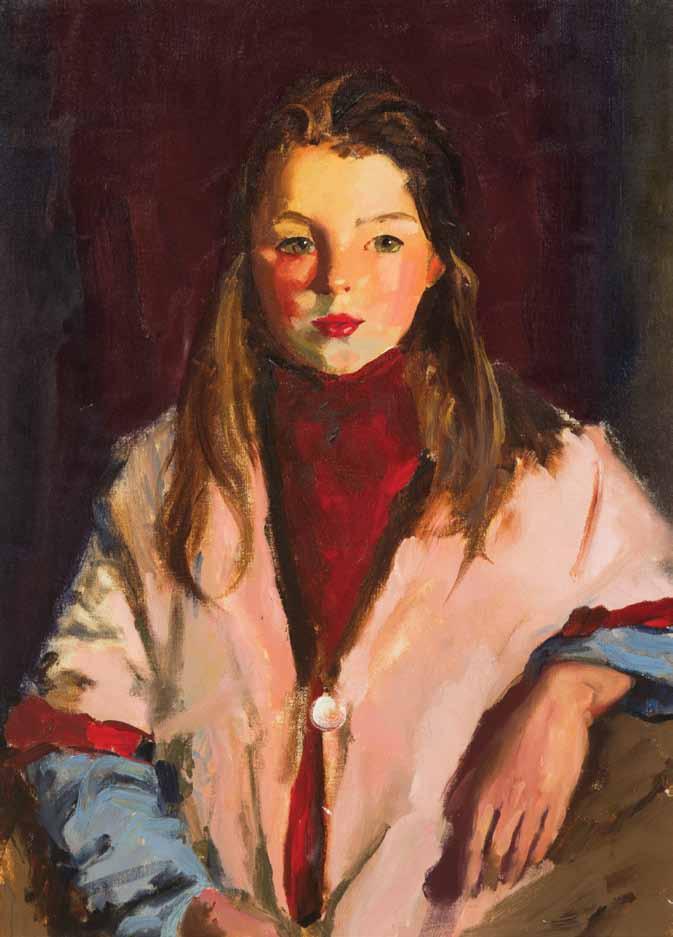
18 Arthur B. Davies (American, 1863-1928) Coast Scene with Ships oil on canvas estate stamped (stretcher) 6 x 15 inches. Property from the Collection of Carol H. and Richard M. Levin, Kansas City, Missouri
Provenance: Chapellier Gallery, New York Acquired directly from the above by the present owner, 1965 $1,000-2,000


19
19 Reginald Marsh (American, 1898-1954) The Aquitania, 1938 watercolor and pencil on paper signed Reginald Marsh, titled and dated (lower right) 13 7/8 x 19 7/8 inches. Property from the Collection of Carol H. and Richard M. Levin, Kansas City, Missouri
Provenance: Private Collection, New Jersey Hirschl & Adler Galleries, New York Acquired directly from the above by the present owner, 1991 $4,000-6,000
20 Charles Burchfield (American, 1893-1967) Basswood Tree in Winter, 1948 watercolor and gouache on paper laid to board monogrammed and dated (lower left); titled and dated (verso) 32 x 26 1/2 inches. Property from the Collection of Carol H. and Richard M. Levin, Kansas City, Missouri
Provenance: Rehn Gallery, New York Joseph and Bernice Tanenbaum, New York ACA Galleries, New York Acquired directly from the above by the present owner, 1976
Literature: J.S. Trovato, Charles Burchfield: Catalogue of Paintings in Public and Private Collections, Utica, New York, 1970, no. 226, p. 1029, illus.
Exhibited: Duluth, Minnesota, University of Minnesota, Tweed Gallery, An Exhibition Commemorating the Dedication of Tweed Gallery, October 19-November 23, 1958 New York, New York, American Academy of Arts and Letters, Charles Burchfield Memorial Exhibition, Paintings and Drawings, March 1-April 21, 1968 Utica, New York, Munson-WilliamsProctor Institute Museum of Art, The Nature of Charles Burchfield, A Memorial Exhibition, April 9-May 31, 1970 $80,000-120,000 CHaRLes BURCHFIeLd baSSwood tree in winter
One of the most original American watercolorists of the 20th century, Charles Burchfield reveled in the sounds, sights, and sensations of nature. The transition of the seasons, the bloom and decay of vegetation, and the effects of weather upon the landscape inspired the artist throughout his career. Burchfield spent his working life immersed in his own local environment in upstate New York, constantly seeking to express his particular vision of the universal forces. In his search, the artist embraced the fantastic and the real to create exuberant compositions that he brought alive through his brushwork and highly personal style.
Three major periods of Burchfield’s career are generally recognized: an early period dating from roughly 1915 to 1921 when he treated landscape in a realistic, decorative, or fantastic manner; a middle period dating from the early 1920s to the 1940s when he painted more realistically; and a late period when he coalesced the two modes to create a distinctly mystical depiction of the world around him. Although his artistic approach transformed over the years, a deep personal symbolism is evident throughout, as Burchfield explored through his paintings both the physical and psychological terrains.
Executed on a full sheet, Basswood Tree in Winter dates from 1948, when Burchfield painted the landscape around him in a more truthful style. Although the watercolor depicts a seemingly quiet moment in the heart of winter, the muted palette is punctuated by the vibrant green and yellow of the evergreen trees to the right. These splashes of color are coupled with the bold black tree, whose branches overarch and frame the left of the composition. These elements combine to create a strong focal point that then recedes into the pale grays, blues, and whites of winter.
Burchfield kept meticulous journals, and on the day he painted this work, he wrote: “The weather milder, loose misty clouds, a strong wind from S.W. When at noon the temperature went up to 38° I decided to paint outdoors. I set up my easel at the N.E. corner of the studio, with an unaccustomed view of our house & Cottrell’s, with the beloved basswood tree at the focal point” (Charles E. Burchfield, Journals, Vol. 49, Sat. Feb. 7, 1948, p. 21). Trees held a symbolic importance for the artist, who often painted them to suggest life and regeneration, death and decay. In Basswood Tree in Winter, he contrasts the constant, lively green of pines against the bare branches of those at rest for the winter. The vitality of the evergreens imbues the snowy scene with a subtle symbolism that promises of regeneration and life in the spring to come.

20
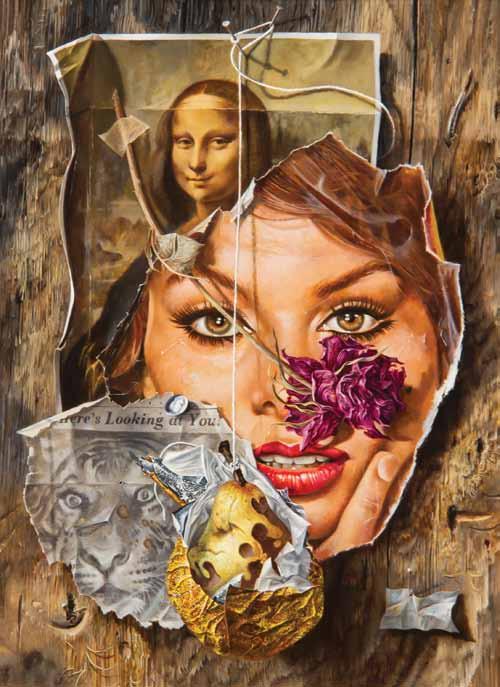
21 21 Aaron Bohrod (American, 1907-1992) The Golden Pear oil on panel signed Aaron Bohrod (lower right) 15 1/4 x 11 1/4 inches. Property from the Collection of Carol H. and Richard M. Levin, Kansas City, Missouri
Provenance: The Milch Galleries, New York Acquired directly from the above by the present owner, 1963 $3,000-5,000
22 Aaron Bohrod (American, 1907-1992) Poussin, Boot oil on gesso panel signed Aaron Bohrod (upper left) 10 x 13 inches. Property from the Collection of Carol H. and Richard M. Levin, Kansas City, Missouri
Provenance: The Milch Galleries, New York Acquired directly from the above by the present owner, 1966 $3,000-5,000
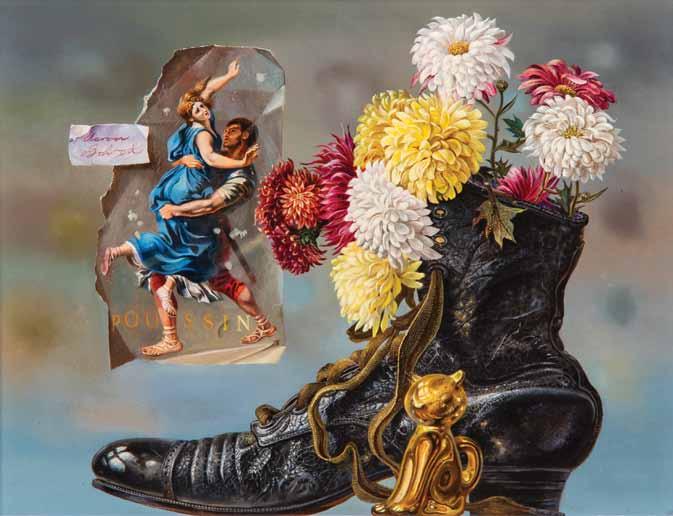
22
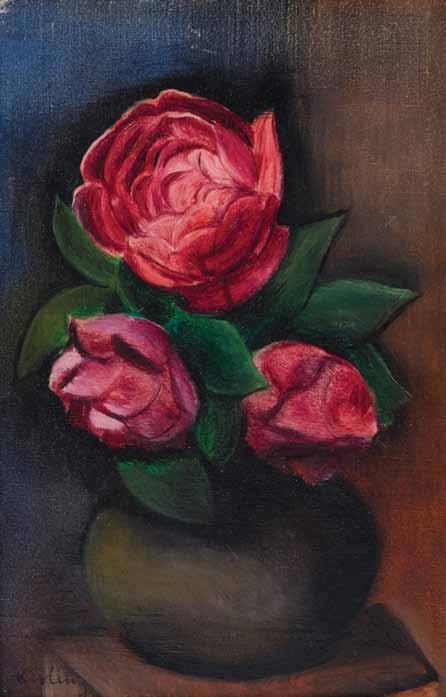
23 23 Moïse Kisling (Polish, 1891-1953) Still Life with Roses in a Vase oil on canvas signed Kisling (lower left) 9 1/2 x 6 3/8 inches. Property from the Collection of Carol H. and Richard M. Levin, Kansas City, Missouri
Provenance: Galerie Zak, Paris Mrs. Lewis Hoffman, Kansas City, Missouri, acquired from the above, 1959 $20,000-40,000

24
24 William James Glackens (American, 1870-1938) Flowers in Hexagonal Ironstone Dish oil on canvasboard titled and numbered 800B (verso) 11 1/4 x 14 3/8 inches. Property from the Collection of Carol H. and Richard M. Levin, Kansas City, Missouri
Provenance: Kraushaar Galleries, New York Dr. and Mrs. Harold Rifkin, New York ACA Galleries, New York Acquired directly from the above by the present owner, 1968 $20,000-40,000
25 Ernest Lawson (American, 1873-1939) Reflections oil on canvas signed E. Lawson (lower left) 20 x 25 inches. Property from the Collection of Carol H. and Richard M. Levin, Kansas City, Missouri
Provenance: The Milch Galleries, New York Chapellier Gallery, New York Acquired directly from the above by the present owner, 1964
Exhibited: Kansas City, Missouri, William Rockhill Nelson Gallery of Art, Atkins Museum of Fine Art, January 22-February 28, 1965 $40,000-60,000

25

26
26 Childe Hassam (American, 1859-1935) Old Barn and the Birches, 1927 oil on panel signed Childe Hassam and dated (lower left); monogrammed and dated (verso) 7 x 10 inches. Property from the Collection of Carol H. and Richard M. Levin, Kansas City, Missouri
Provenance: Estate of the artist American Academy of Arts and Letters, New York The Milch Galleries, New York Acquired directly from the above by the present owner, 1962
This painting will be included in Stuart P. Feld’s and Kathleen M. Burnside’s forthcoming catalogue raisonné of the artist’s works. $60,000-80,000

27 27 Eugene Edward Speicher (American, 1883-1962) Flowers, 1944 oil on canvas signed Eugene Speicher (lower left); inscribed and dated (lower right) 13 1/2 x 10 1/2 inches. Property from the Collection of Carol H. and Richard M. Levin, Kansas City, Missouri
Provenance: The Milch Galleries, New York Acquired directly from the above by the present owner, 1963 $1,000-2,000
28 Jack Levine (American, 1915-2010) The Waiting Lady, 1972 oil and pastel on paper signed J. Levine (lower left) 39 1/4 x 25 1/4 inches. Property from the Collection of Carol H. and Richard M. Levin, Kansas City, Missouri
Provenance: Kennedy Galleries Inc., New York Acquired directly from the above by the present owner, 1981
Exhibited: Ontario, Canada, Rodman Hall Arts Center, Jack Levine, April 7-30, 1978 Glen Falls, New York, The Hyde Collection, Jack Levine, July 2-September 3, 1978 New York, New York, Kennedy Galleries, Jack Levine Recent Work, 1975, no. 5 $2,000-4,000

28

29

30 29 Harry McCormick (American, b. 1942) Butcher’s Break oil on canvas signed McCormick (lower right) 13 x 20 inches. Property from the Collection of Carol H. and Richard M. Levin, Kansas City, Missouri
Provenance: ACA Galleries, New York Acquired directly from the above by the present owner, 1973 $400-600
30 Ben Johnson (American, 20th century) Three Green Apples, 1963 oil on canvas signed Ben Johnson and dated (lower right) 11 1/2 x 13 1/2 inches. Property from the Collection of Carol H. and Richard M. Levin, Kansas City, Missouri
Provenance: Gallery 63 Inc., New York $200-400
31 Jules Pascin (French, 1885-1930) Nude ink on paper signed Pascin (lower right) 12 1/4 x 12 1/4 inches. Property from the Collection of Carol H. and Richard M. Levin, Kansas City, Missouri $1,000-2,000
32 Harvey Gordon (20th century) Interior with Figure, 1970 oil on masonite signed Harvey Gordon, titled and dated (verso) 34 1/2 x 22 1/2 inches. Property from the Collection of Carol H. and Richard M. Levin, Kansas City, Missouri $150-250

31

32
33 David Burluik (Ukrainian, 1882-1967) Still Life - Flowers on Shore oil on canvas laid to masonite signed Burluik (lower right) 17 3/8 x 12 3/4 inches. Property from the Collection of Carol H. and Richard M. Levin, Kansas City, Missouri
Provenance: Lawrence Gallery, Kansas City, Missouri Acquired directly from the above by the present owner, 1964 $5,000-7,000
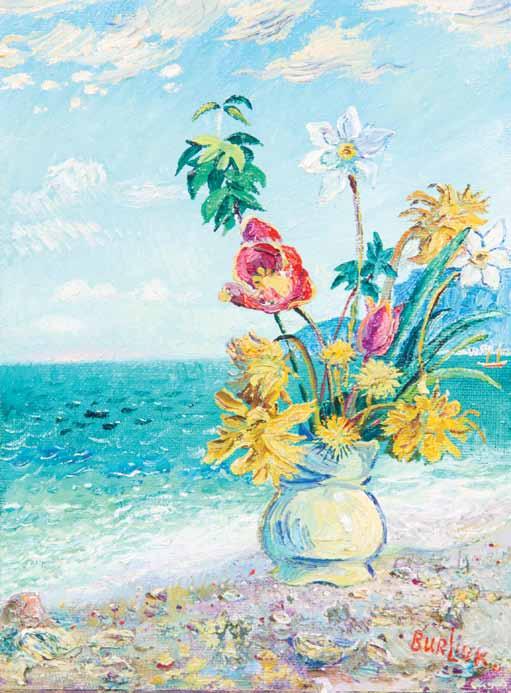
33

34
34 Luigi Lucioni (American/Italian, 1900-1988) Blue and White Variations, 1965 oil on canvas signed Luigi Lucioni and dated (lower right) 20 x 17 1/4 inches. Property from the Collection of Carol H. and Richard M. Levin, Kansas City, Missouri
Provenance: The Milch Galleries, New York Acquired directly from the above by the present owner, 1965 $10,000-15,000
upComInG auCtIon sCHeduLe
naPLes sPRInG aUCTIOn APRIL 9 | ONLINE ONLY
FIne jeweLRy APRIL 19–20 | CHICAGO
FIne TImePIeCes APRIL 20 | CHICAGO
LUxURy aCCessORIes and VInTaGe FasHIOn APRIL 21–22 | CHICAGO
FIne sILVeR and OBjeCTs OF VeRTU APRIL 30 | CHICAGO
20TH CenTURy deCORaTIVe aRTs MAY 1 | CHICAGO
sT. LOUIs sPRInG aUCTIOn MAY 6 | ST. LOUIS
FIne BOOKs and manUsCRIPTs MAY 7 | CHICAGO
mILwaUKee sPRInG aUCTIOn MAY 15 | MILWAUKEE
ameRICan and eUROPean aRT MAY 20 | CHICAGO DEADLINE MARCH 20 PROPeRTy FROm THe COLLeCTIOn OF CaROL H. and RICHaRd m. LeVIn MAY 20 | CHICAGO
FIne PRInTs MAY 21 | CHICAGO DEADLINE MARCH 20
aRTs OF THe ameRICan wesT JUNE 4 | DENVER DEADLINE APRIL 17
PROPeRTy FROm THe eBOny FasHIOn FaIR COLLeCTIOn JUNE 10 | CHICAGO
maRKeTPLaCe JUNE 17 | ONLINE ONLY
PROPeRTy FROm THe HIGH mUseUm OF aRT JUNE 23 | CHICAGO
FIne aRT maRKeTPLaCe JUNE 24 | ONLINE ONLY
FIne FURnITURe and deCORaTIVe aRTs JULY 13–14 | CHICAGO DEADLINE MAY 14
asIan maRKeTPLaCe JULY 15 | CHICAGO
CLassIC GLass JULY 17 | ONLINE ONLY DEADLINE MAY 18


